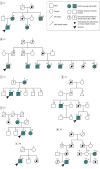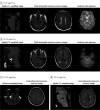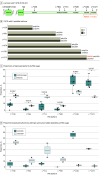An AluYa5 Insertion in the 3'UTR of COL4A1 and Cerebral Small Vessel Disease
- PMID: 38630472
- PMCID: PMC11024774
- DOI: 10.1001/jamanetworkopen.2024.7034
An AluYa5 Insertion in the 3'UTR of COL4A1 and Cerebral Small Vessel Disease
Abstract
Importance: Cerebral small vessel diseases (CSVDs) account for one-fifth of stroke cases. Numerous familial cases remain unresolved after routine screening of known CSVD genes.
Objective: To identify novel genes and mechanisms associated with familial CSVD.
Design, setting, and participants: This 2-stage study involved linkage analysis and a case-control study; linkage analysis and whole exome and genome sequencing were used to identify candidate gene variants in 2 large families with CSVD (9 patients with CSVD). Then, a case-control analysis was conducted on 246 unrelated probands, including probands from these 2 families and 244 additional probands. All probands (clinical onset <age 55 years and ≥1 first-degree relative with CSVD) were referred to the French cerebrovascular referral center between 2013 and 2023. The large-scale gnomAD structural variant database and 467 healthy individuals of French ancestry were used as a control group.
Main outcomes and measures: A pathogenic AluYa5 insertion was identified within the COL4A1 3'UTR in the 2 large families with CSVD. Reverse transcriptase-quantitative polymerase chain reaction (RT-qPCR), Western blot, and long-read RNA sequencing were used to investigate outcomes associated with the insertion using patient fibroblasts. Clinical and magnetic resonance imaging features of probands with variants and available relatives were assessed.
Results: Among 246 probands (141 females [57.3%]; median [IQR] age at referral, 56 [49-64] years), 7 patients of French ancestry carried the insertion. This insertion was absent in 467 healthy French individuals in a control group (odds ratio, ∞; 95% CI, 2.78 to ∞; P = 5 × 10-4) and 10 847 individuals from the gnomAD structural variant database (odds ratio, ∞; 95% CI, 64.77 to ∞; P = 2.42 × 10-12). In these 7 patients' families, 19 family members with CSVD carried the insertion. RT-qPCR and Western blot showed an upregulation of COL4A1 mRNA (10.6-fold increase; 95% CI, 1.4-fold to 17.1-fold increase) and protein levels (2.8-fold increase; 95% CI, 2.1-fold to 3.5-fold increase) in patient vs control group fibroblasts. Long-read RNA sequencing data showed that the insertion was associated with perturbation in the use of canonical COL4A1 polyadenylation signals (approximately 87% of isoforms transcribed from the wild type allele vs 5% of isoforms transcribed from the allele with the insertion used the 2 distal canonical polyadenylation signals). The main clinical feature of individuals with CSVD was the recurrence of pontine ischemic lesions starting at an early age (17 of 19 patients [89.5%]).
Conclusions and relevance: This study found a novel mechanism associated with COL4A1 upregulation and a highly penetrant adult-onset CSVD. These findings suggest that quantitative alterations of the cerebrovascular matrisome are associated with CSVD pathogenesis, with diagnostic and therapeutic implications.
Conflict of interest statement
Figures





References
-
- Gorelick PB, Scuteri A, Black SE, et al. ; American Heart Association Stroke Council, Council on Epidemiology and Prevention, Council on Cardiovascular Nursing, Council on Cardiovascular Radiology and Intervention, and Council on Cardiovascular Surgery and Anesthesia . Vascular contributions to cognitive impairment and dementia: a statement for healthcare professionals from the American Heart Association/American Stroke Association. Stroke. 2011;42(9):2672-2713. doi:10.1161/STR.0b013e3182299496 - DOI - PMC - PubMed

